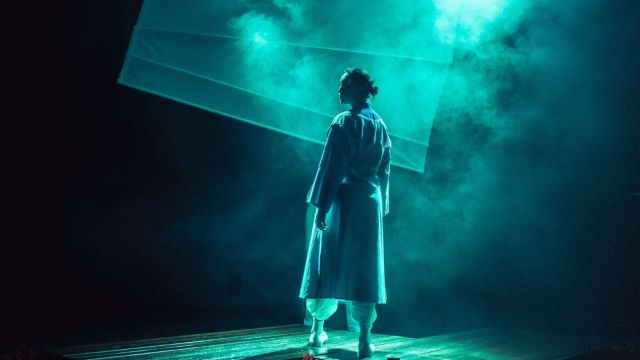Scenes From a Yellow Peril
Image: Daphne Chen stands centre stage. Photo by Nathaniel Knight.
Scenes From a Yellow Peril, presented at QPAC’s Cremorne Theatre by The Reaction Theory, is not easily defined. It is part poem, part theatre, part reckoning. Co-directed and produced by Chelsea August and Egan Sun-Bin, the show avoids traditional narrative structure. Instead, it unfolds as a series of scenes, fragments, and provocations that accumulate into something far more powerful than a conventional plot. This bold work explores racism, identity, cultural loss, and generational pressure with a fierce combination of intellect, emotion, and artistry.
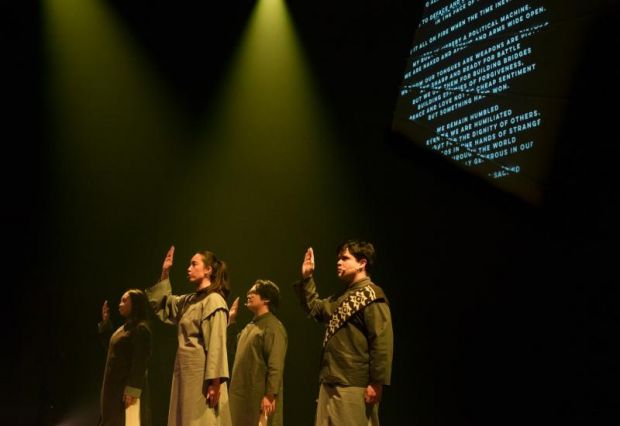
Image: The ensemble stands in front of the projected sail as they pledge allegiance to a new manifesto. Photo by Cecilia Martin
Before the show began, Chelsea August hosted a staged introduction with the ensemble, Daphne Chen, Chris Nguyen, Jazz Zhao, and Peter Wood. They spoke about their day jobs, their family origins, and what brought them to Australia. The opening Q&A, warm and disarming, felt like meeting someone for the first time and realising you already share a language. It was a very clever way to build trust before the floor beneath you begins to shift.
The performance began with a series of viral clips and stereotypes of Asian identity performed by the ensemble which was projected onto a billowing white sail. This white sail, reminiscent of those used on traditional Chinese boats, hung above the set throughout the production. It is used to introduce each scene and chapter of the performance, other times to show projected visuals to punctuate the content of the play. This first visual lands hard. While the performers mimic, disrupt, and reclaim these projected videos, the humour is both familiar and discomforting.
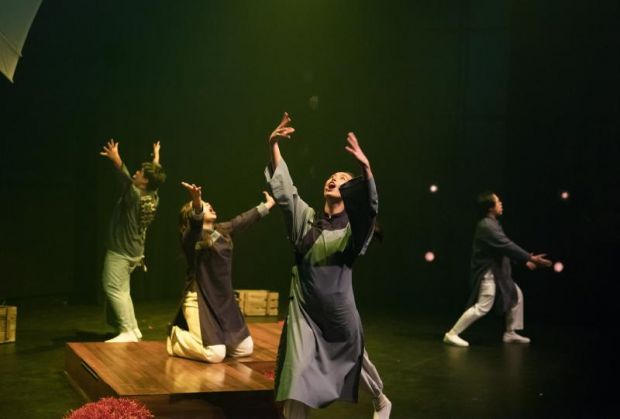
Image: The ensemble, mouths agape, reach out with open arms in various directions. Photo by Ceclia Martin
From there, the show surges forward. The structure of the show is fluid. Rather than following a linear narrative, the production moves through a sequence of vignettes that blend slam poetry, direct address, satire, music, and movement. The effect is unrelenting in its energy and scope. Moments of intimacy are layered with humour and rage. Joy collides with grief. The show doesn’t offer answers but insists the questions be heard.
What makes the production so effective is how it invites vulnerability, both from the cast and the audience. Each of the four performers offer something raw and unmistakably personal. Their presence on stage feels grounded in lived experience. There’s a natural rhythm to their performances that builds trust quickly and lets them take the audience somewhere far less comfortable.
Among the many standout moments, the beginning two scenes recounting accumulated microaggressions hits with force. The "Rage Poem" features the ensemble’s voices colliding in rhythm and sync. It is angry, precise, and exhilarating to watch while clearly showcasing how tightknit this ensemble has become throughout this process. Then comes “Humiliations,” written by the cast. A rapid-fire litany of real-life microaggressions experienced by the cast. The scene makes it impossible to keep tally, and the cumulative effect is eye-opening. There is power in hearing these indignities laid out with such clarity.
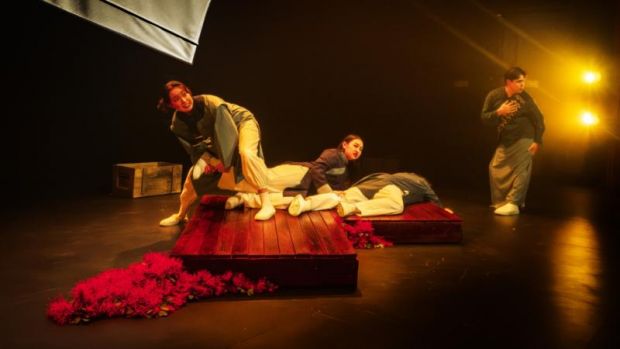
Image: Chris Nguyen lies beside Daphne Chen who is being dragged by across the stage by Jazz Zhao, while Peter Wood stands nearby looking out at the audience. Photo by Nathaniel Knight
Humour returns throughout, cutting through the tension but never erasing it. For instance, a segment titled I Cannot Invite My Parents to My Play comes like a welcome reprieve. Delivered like a pop ballad led by Jazz Zhao, with spoken word verses and back up singing by the ensemble, it doesn’t overreach emotionally while balancing the reality of the words being sung. In another scene, Jazz Zhao and Daphne Chen deconstruct fetishisation through satire. With pixelated projections of adult videos on the white sail above them, the pair act out the stereotypical pornographic ‘stories’ that features Asian women. The scene ends with Peter Wood and Chris Nguyen popping party streamers at the climax. The room laughs, then goes quiet. The most powerful moments of the show do exactly that – satire is used not to soften the blow, but to sharpen it. The weight of the absurdity barely settles in just as the show phases back into another Q&A session.
Throughout the piece, these Q&A interludes return like a breath of fresh air. They break the rhythm while deepening the connection. One moment touches on tokenism, another questions whether racism can ever truly be “fixed.” There are no easy answers, and the play doesn’t pretend there are.
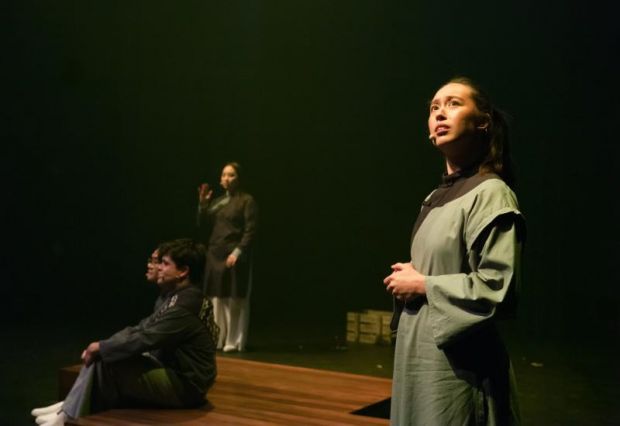
Image: Daphne Chen looks pensive, with Peter Wood, Chris Nguyen and Jazz Zhao in the background.
Photo by Cecila Martin.
A scene about romantic relationships turns these questions on the audience. The scene explores the quiet, persistent hurt of being “tolerated” rather than truly accepted. Peter Wood was particularly powerful in this scene as he teetered on the edge of tears and showed just how close to home these situations hit. The audience feels it too as it forces you to ask hard questions of yourself. Have I ever allowed these things to go unchecked? Am I one of the “good ones,” or have I just been passive?
There are moments that hit like a whisper rather than a shout. In one of the most powerful scenes, Daphne Chen, Chris Nguyen, and Peter Wood carry lanterns as their only light source as they symbolically shine a light on the very real violence enacted on Asian people. They speak the names of victims of racially motivated murders. Each word carries weight. In particular, Daphne Chen's delivery has such raw emotional depth that each punctuated word sends shivers down your spine.
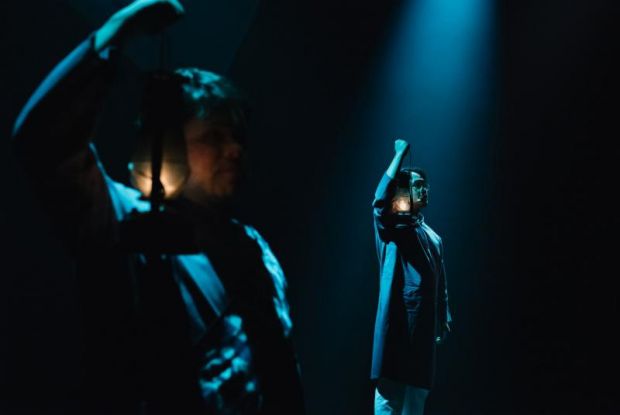
Image: Peter Wood and Chris Nguyen. Photo by Cecila Martin.
This is not easy theatre, nor is it meant to be. However, it is deeply rewarding. Scenes From a Yellow Peril doesn’t seek pity or applause. It asks for presence, attention, and reflection. It is a space carved out by voices that are too often asked to wait or water themselves down. Here, they speak fully. It is both challenging and also inviting. It offers humour without undercutting pain. It offers vulnerability without asking to be rescued. For some, it will feel like a mirror. For others, it may feel like a door they’ve never opened. Either way, it matters that it exists.
At its heart, Scenes From a Yellow Peril is a powerful act of storytelling. The playwright, Nathan Joe has created a mosaic of resistance and remembrance, of grief and satire, of presence and purpose. This production created by The Reaction Theory does not coddle you. It does not try to make you feel better about the state of things. Instead, it lays bare the quiet cruelties and cultural fractures that many choose not to see. The cast, Daphne Chen, Chris Nguyen, Peter Wood, and Jazz Zhao, offer themselves without hesitation. Their performances are generous, unflinching, and unforgettable. For those willing to engage with it fully, it leaves something behind. Scenes From a Yellow Peril is an urgent and honest message that will no longer be silenced.
Review by Rebecca Lynne
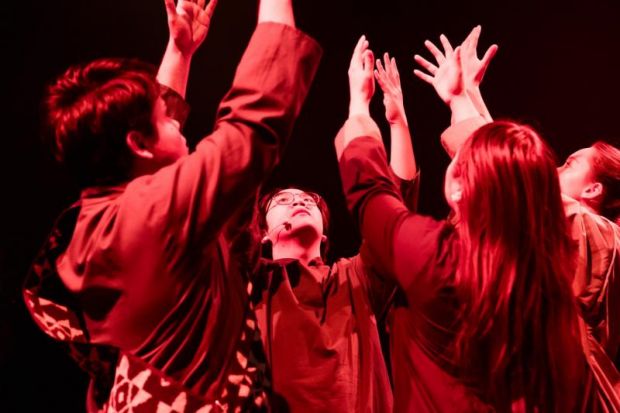
Image: The ensemble stands in a circle and reach up while bathed in a glow of red light. Photo by Cecila Martin.
Tickets: https://www.qpac.com.au/whats-on/2025/scenes-from-a-yellow-peril
Dates: 3rd to 12th of July 2025
Venue: Cremorne Theatre, QPAC
The Reaction Theory: https://www.thereactiontheory.net/
Subscribe to our E-Newsletter, buy our latest print edition or find a Performing Arts book at Book Nook.

